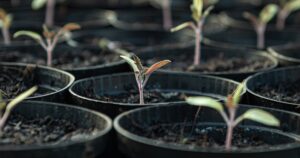
Successful seed starters know that January is the time to start thinking about what you want to grow in your summer (or spring) vegetable garden. Get a head start by planning now for a fruitful harvest later.
Before starting seeds indoors, you should plan out your garden and figure out exactly what you have room to grow. You don’t want to start too much more seed than you plant to plant. You should, however, start a few extras in case they don’t germinate or don’t transplant well. Draw out your garden space and figure out which plants and varieties you want. I suggest that you grow what your family usually buys at the grocery store, that way you are saving money and making good use of your garden.
The most common method to start seeds indoors involves using pellets or soil in a tray and placing a dome over that tray. The dome helps keep the humidity high, which will help with germination. It is also helpful to keep a seedling heat mat under your tray until your seeds sprout. Seed starting trays, domes, and heat mats can be found at most gardening centers. Most seeds will germinate better if they are kept in darkness until they sprout. You will also need to keep them moist. A spray bottle will be gentle and not wash away newly planted seeds. Seeds have different germination times, so be sure to check the seed packet or do some research so you know when to expect to see sprouts.
When to start your seeds depends on the date you can plant the crop outdoors. You can find some handy seed starting charts online, or you can make your own. You need to know your average first frost free date, which in Pueblo is usually around May 1. You will then need to do some research, or look on your seed packet, to determine when you can set out the plant (one week after last frost, for example). The next thing you need to know is how long before the set out date should you start the seeds, this is really easy to find online, it may be on your seed packet, or you can call your Master Gardeners at the CSU Extension office. I suggest using a calendar to keep track of when to start your different seeds and when they can go outside. Make sure to gradually give them more and more time outside to get used to the elements before planting them in your garden.
If you don’t have space for a large outdoor garden, you can still grow your own food using containers. Most all plants can grow and do well in a container. You will probably need to water and fertilize more than if they were in the ground. For plants like peppers and tomatoes, you will want a two to five-gallon container that is around ten to twelve inches deep. Tomatoes and cucumbers will need a cage or trellis inside the container for support. Plants like lettuce and greens can go into a more shallow container, since they are much smaller.


